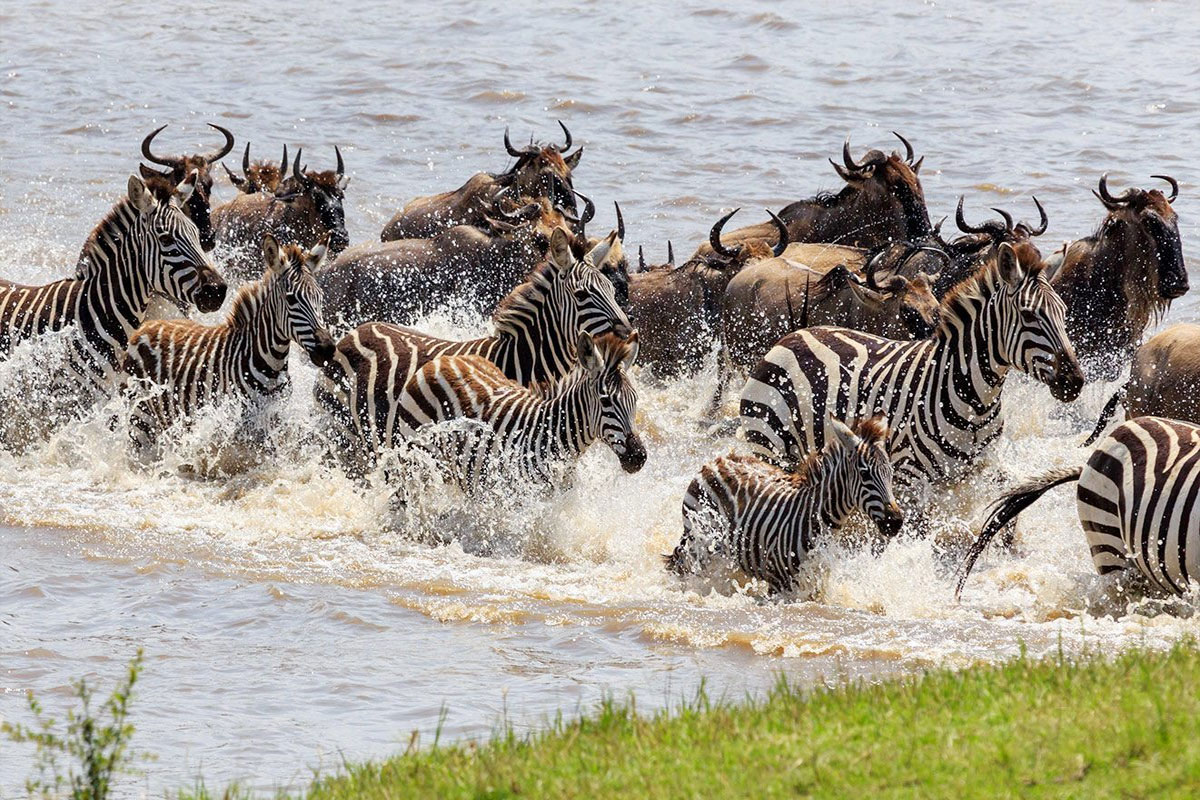What is the Great Migration?
Throughout the year, East Africa’s wide-open grasslands are the setting for the Great Migration as millions of wildebeests, zebras, antelopes and other herd animals make the move from the Serengeti Park in Tanzania to the Kenya in Masai Mara. While significant numbers into the multi-thousands (mega-herds) do clump together, more often there are smaller herds spread throughout a region or multiple regions. All of these herds make the Movement with two things in mind: fresh grazing lands and enough water.
“The smell of rain and sound of thunder spur the migration forward, but sometimes sideways and even back. Along the way, some many migrating animals become prey to predators including lions, cheetahs, crocodiles and hyenas. In fact, around 380,000 wildebeests and 70,000 zebras perish in this tough trek way, mainly younger ones. “Many times, mother wildebeests will just start running and keep running, not knowing that their young can’t keep up.”
A long, mile journey A year
Though it is sometimes referred to as annual event, the Great Migration is actually a fluid and continuous, year-long journey of animals migrating through Tanzania and Kenya. In total, this circuit spans some more than 1000 miles. Yes, dramatic river crossings are part of the herbivorous migration, but they are only a small part of a far more complex chain of events that play out from season to season across two different countries destinations. These events include mating rituals, calving and the shifting fortunes of the herd, all of which are influenced by the subtle changes in rainfall that occur year over year.

When is the best time to see the Great Migration? Where?
The answer to the most common question about this epic movement of animals chasing water and food across two Destinations with two different ecosystems is anything but simple. Rain patterns have the ultimate say in the herds’ plans and movements, but in generally the herds of the Great Migration typically follow a similar path year over year that begins in Tanzania’s Ndutu in southern part of Serengeti and ends in the Masai Mara in Kenya.
December–June Wildebeest Babies and stalking lions in Serengeti National Park
From December through early March, the herds are mainly found in the Southern Tanzania between Ngorongoro conservation Area (Ndutu). “Wildebeests tend to congregate in February, when they give birth to up to 800,000 calves over a one- to three-week period. The reason for concentrating in the south is to give their calves the richest milk, as the soil and grass is rich in potassium, calcium and phosphorus from the volcanic eruptions of two to three million years ago. The Serengeti’s short grass are also a draw. “Wildebeests prefer to calve here, without fear of predators that typically lurk in taller grass.” Even still, prides of lions are living their best lives at this time and predator action is a-plenty.
April to May mark the season of long rains. The herds begin to move north across the central and western corridor of Serengeti, grazing hungrily as they go. The food supply begins to vanish. By most of the grass is gone.” As the Serengeti dries up, the Migration follow the Grumeti River in west.
From June to July, the herds are grazing their way through the Serengeti’s western corridor and continue to push north towards the Masai Mara. On the June the Grumeti River is low, often leaving crocodile-infested pools as the only water source in the area, and both wildebeests and zebras drink almost 5-7 litres of water, By July some of the herd can be found in the northern reaches of Tanzania, near Kenya’s border. At this time, the herds also hasten their approach to the Masai Mara as the reserve receives rain from Lake Victoria, about few miles away.
August to September: Dramatic River crossings in the Masai Mara.
Large portions of the migration tend to arrive into the Masai Mara by August, when traffic jams and crossing at the Mara rivers are apt to reach their frenzied climax. “August is probably the best month to catch a crossing, but take a book and plenty of patience, as it is a waiting game, Feast-or-famine crocs lick their chops for four months of the year in total, though they can survive on fish and the fat in their tails for a year or more.”
From October through November, the herds start to leave the Masai Mara and turn southern. Ever on the move for greener pastures, they begin their return to the Serengeti plain for the start of Tanzania’s rainy season. On August in Masai Mara grasslands are pool-table flat. The million-beast march starts the winding journey south, consuming approximately more than 4,000 tons of grass a day.”

What’s the best way to explore the Great Migration?
A well-designed East Africa safari in, Tanzania and Kenya or both can put you right in line with the action. The modern luxury safari offering everything from Tailor Made private safaris, Hazzes Adventure safari Expert together will help you to make your unforgettable itineries because they know where to be and when for the Great Migration.

